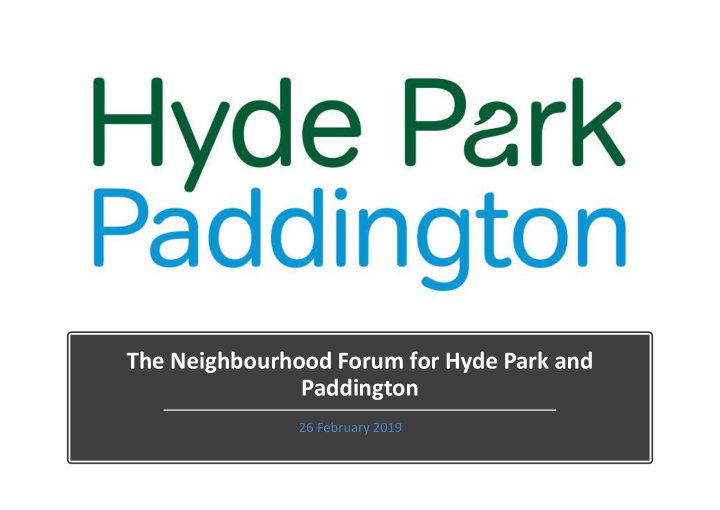



The Neighbourhood Forum for Hyde Park and Paddington 26 February 2019
Chronology • A joint application by the Hyde Park Estate Association, Paddington Now Business Improvement District and the Paddington Partnership to designate Neighbourhood Area in April 2013 • Hyde Park and Paddington Business Neighbourhood Area designated by City of Westminster in March 2014 • Public meetings on 22 March 2016 and 22 June 2016 • Neighbourhood Forum application made in December 2016 • Neighbourhood Forum designated by WCC in June 2017
The Hyde Park and Paddington Neighbourhood Area, as designated in March 2014
• Accompanied the application to designate the Forum • Membership open to residents, Officially businesses or organisations from within Neighbourhood, land or Adopting property owners, PaddingtonNow BID and Marble Arch BID the • Always a minimum of 21 members, Constitution currently 103 • General meetings twice a year once established, quorum of 18 members
• Steering Group of 18 members; nine residential, nine non-residential • Residential must include one resident from HPEA, business must include one from PaddingtonNow BID and one About the from Marble Arch BID • Officer positions on Steering Group of Constitution Chair, Vice-chair, Treasurer and Secretary (for up to two years) • Chair and Vice-chair must not be from within the same membership category
Residential Nominations: • Sergio Chiquetto • Sarah Clifford Election of • Matthew Lindsay Steering • Bernadette McKernan • Sally Martin Group and • Rev Stephen Mason • Nikhil Shah Officers • Allen Zimbler • Vacancy (resident north of Praed Street)
Business Nominations: • Kay Buxton, The Paddington Partnership • Paul Charalambous, Stylotel and Election of Sussex Arms • Will Clayton, PaddingtonNow BID Steering • Mike Fairmaner, Marble Arch BID • Isabel Jeans, British Land Group and • Ian Lush, Imperial Health Charity • Mark McKeown, The Church Officers Commissioners • Andrew Scrivener, European Land • Vaughan Smith, Frontline Club and Restaurant
Election of Chair Allen Zimbler Steering Vice-chair Kay Buxton Secretary Sarah Clifford Group and Treasurer Andrew Scrivener Officers
The Forum’s Remit Enables community to have stronger role in shaping area The Forum has a commitment to shape the vision for the future Consider new development proposals regeneration of this historic quarter of London and ensure it maintains its Create relationships between residents, status as a prime location businesses and property owners in the in the heart of area Westminster. WCC required to consult and engage It is the only body that can Forum on 15% of value of CIL generated produce a neighbourhood in Forum area plan for the area and represent the whole area Can create a Neighbourhood Plan in discussions with public agencies.
• Neighbourhood planning was introduced to enable local communities to take ownership of the planning and development in their area. • If an area feels that it has scope to accommodate additional development over and above that which is planned in Neighbourhood the council's plan or it feels the planned development should be provided in a Planning different way, then it may consider forming a neighbourhood forum and producing a neighbourhood development plan. • It is important to note that neighbourhood development plans are not tools to prevent or resist development that is planned
• There are 16 designated Neighbourhood Forums in Westminster Westminster • Only two to date have produced a plan Neighbourhood • Knightsbridge – Forum designated July Forums and 2015, plan formally adopted by the City Plans Council 11 December 2018 • Mayfair – Forum designated January 2014 and renewed January 2019, plan heading to Public Inquiry later in 2019
A Neighbourhood Plan for Hyde Park Paddington? • Which of the Council’s planning policies do not currently meet the needs of the area? • Draft City Plan due out early spring 2019 • A plan would take at least 3 years and considerable expense • Bear in mind that neighbourhood plans cannot resist development
Indicative Timescale and Costs • 8-16 months: Develop draft Plan, build evidence base, conduct environmental assessment and engage communities • 3-8 months: Pre-submission consultation and review and changes • 3-6 months: Formal consultation and appointment of Examiner • 3-9 months: Examination, writing report, modifications by WCC • 3-6 months: WCC to agree date for referendum, 28 notification period. • Single voting day • 1 month: Plan Adopted • Total period: 21-46 months (c. 2-4 years) • Costs: Mayfair Neighbourhood Plan costs estimated at £100,000 • Research/evidence base, consultation and planning consultant fees account for most of this
• Many developments pay a CIL levy to the City Council for it to spend on infrastructure • This can be spent across the city, and need not relate to where development has taken place • Where there is a neighbourhood plan, the City Council must allocate at least 25% of the Community CIL raised from developments in the area to that neighbourhood. And should consult with Infrastructure the Forum on its expenditure. Levy • Without a plan, the City Council must allocate 15% of the CIL raised from developments in the area to that neighbourhood • Note that the Council retains the CIL levy and makes decision on how it is spent (only where there is a town or parish Council does the local authority have to pass the CIL levy over to that organisation for it to spend how it wishes)
• Praed Street – improving public realm and retailing • Short-term lets – joining forces and acting together • Vice – being a much stronger lobbying voice • Gateways and connections – promoting schemes to link old and new Paddington, and transport nodes (especially in relation to Workshop of Shadow Steering CIL) Group, September 2018 – what • Housing – local policy on key worker housing are the pressing issues locally?
Questions and Discussion
Next Steps and Date of Next Meeting
Recommend
More recommend